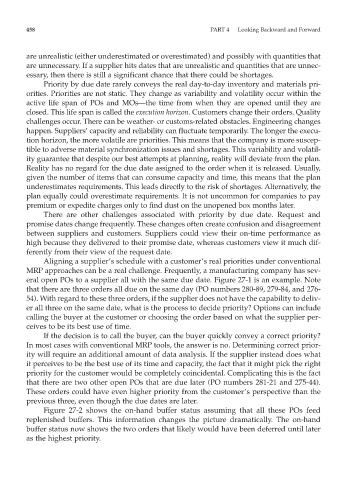Page 481 - Orlicky's Material Requirements Planning
P. 481
458 PART 4 Looking Backward and Forward
are unrealistic (either underestimated or overestimated) and possibly with quantities that
are unnecessary. If a supplier hits dates that are unrealistic and quantities that are unnec-
essary, then there is still a significant chance that there could be shortages.
Priority by due date rarely conveys the real day-to-day inventory and materials pri-
orities. Priorities are not static. They change as variability and volatility occur within the
active life span of POs and MOs—the time from when they are opened until they are
closed. This life span is called the execution horizon. Customers change their orders. Quality
challenges occur. There can be weather- or customs-related obstacles. Engineering changes
happen. Suppliers’ capacity and reliability can fluctuate temporarily. The longer the execu-
tion horizon, the more volatile are priorities. This means that the company is more suscep-
tible to adverse material synchronization issues and shortages. This variability and volatil-
ity guarantee that despite our best attempts at planning, reality will deviate from the plan.
Reality has no regard for the due date assigned to the order when it is released. Usually,
given the number of items that can consume capacity and time, this means that the plan
underestimates requirements. This leads directly to the risk of shortages. Alternatively, the
plan equally could overestimate requirements. It is not uncommon for companies to pay
premium or expedite charges only to find dust on the unopened box months later.
There are other challenges associated with priority by due date. Request and
promise dates change frequently. These changes often create confusion and disagreement
between suppliers and customers. Suppliers could view their on-time performance as
high because they delivered to their promise date, whereas customers view it much dif-
ferently from their view of the request date.
Aligning a supplier’s schedule with a customer’s real priorities under conventional
MRP approaches can be a real challenge. Frequently, a manufacturing company has sev-
eral open POs to a supplier all with the same due date. Figure 27-1 is an example. Note
that there are three orders all due on the same day (PO numbers 280-89, 279-84, and 276-
54). With regard to these three orders, if the supplier does not have the capability to deliv-
er all three on the same date, what is the process to decide priority? Options can include
calling the buyer at the customer or choosing the order based on what the supplier per-
ceives to be its best use of time.
If the decision is to call the buyer, can the buyer quickly convey a correct priority?
In most cases with conventional MRP tools, the answer is no. Determining correct prior-
ity will require an additional amount of data analysis. If the supplier instead does what
it perceives to be the best use of its time and capacity, the fact that it might pick the right
priority for the customer would be completely coincidental. Complicating this is the fact
that there are two other open POs that are due later (PO numbers 281-21 and 275-44).
These orders could have even higher priority from the customer’s perspective than the
previous three, even though the due dates are later.
Figure 27-2 shows the on-hand buffer status assuming that all these POs feed
replenished buffers. This information changes the picture dramatically. The on-hand
buffer status now shows the two orders that likely would have been deferred until later
as the highest priority.

